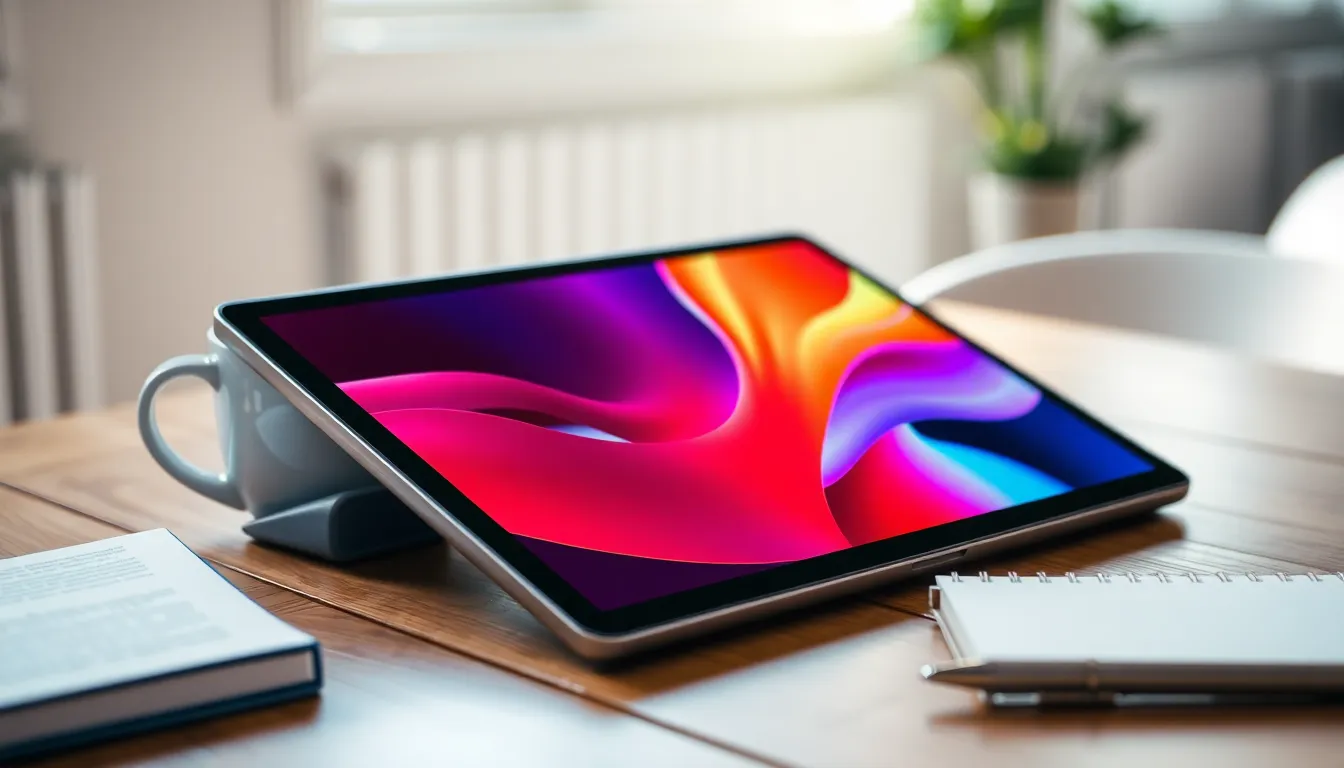Table of Contents
ToggleIn a world where tablets reign supreme, choosing the right one can feel like trying to pick a favorite child—almost impossible! With sleek designs and powerful features, these devices promise to revolutionize the way we work, play, and binge-watch cat videos. But how do you know which one’s worth your hard-earned cash?
Overview of Tablets Comparison
Choosing the right tablet requires careful consideration of several factors. Various models feature different operating systems, screen sizes, and hardware specifications, which influence user experience. High-performance tablets cater to professionals needing powerful applications, while others focus on entertainment and casual use.
Battery life remains a critical aspect, with many tablets offering anywhere from 8 to 15 hours of usage on a single charge. Portability is another advantage, as most tablets weigh between 0.5 to 1.5 pounds, making them easy to carry.
The display quality often varies across brands. Some tablets boast high-resolution screens that enhance video streaming and gaming experiences. Connectivity options, including Wi-Fi and cellular capabilities, also differ, impacting how users access the internet on the go.
Storage capacity is essential, with choices typically ranging from 32GB to 1TB. Users should evaluate their own needs; extensive media consumption or productivity tasks may require larger storage.
Price points fluctuate significantly. Budget-friendly tablets can start as low as $100, while premium options may exceed $1,000. Understanding one’s budget helps narrow down choices.
Reviewing user feedback provides insights into reliability and performance. Customers often share their experiences with specific models, highlighting pros and cons.
Features like stylus compatibility, detachable keyboards, and multi-window capabilities affect functionality. These added features can make certain tablets more suitable for specific tasks, enhancing their value.
Key Features to Consider

When selecting a tablet, certain features significantly impact the user experience. Attention to these elements ensures a more informed decision.
Display Quality
High-resolution displays enhance the visual experience on tablets. Typically, options include LCD and OLED screens, with the latter offering deeper blacks and vibrant colors. Most premium models boast resolutions of at least 1080p, while some excel with 4K capabilities. Brightness levels matter too, where displays with higher nits provide better outdoor visibility. Size varies from 7 inches for portability to 12.9 inches for immersive viewing. Touch responsiveness and refresh rates can improve usability, especially for gaming and streaming activities.
Battery Life
Battery life ranges significantly among tablets, impacting how long users can enjoy them away from an outlet. Many tablets offer usage times between 8 to 15 hours based on different activities. Generally, devices with larger batteries tend to provide extended use, while heavier performance tasks may draw more power. Standby mode also affects battery longevity; tablets that efficiently manage background processes retain power better. Fast charging capabilities further enhance convenience, allowing users to quickly recharge during short periods.
Performance
Performance hinges on the processor and RAM, which determine the tablet’s speed and multitasking capabilities. Processors like Apple’s M1 or Qualcomm’s Snapdragon series lead the market with performance and efficiency. Often, tablets equipped with 4GB to 16GB of RAM handle demanding applications with ease. Graphics processing units (GPUs) also play a role in performance, particularly for gaming and creative software. User reviews often highlight the importance of smooth operation for applications and browsing, reinforcing the need for robust performance specifications.
Popular Tablet Models
Tablets come in various models, each catering to different user needs. Here’s an overview of some popular options.
Apple iPad
Apple iPad remains a top choice for many users. It features an A14 Bionic chip, providing robust performance and efficiency. The Retina display offers vibrant colors and sharp visuals, enhancing user experience. Storage options range from 64GB to 2TB, accommodating various applications and files. Battery life extends up to 10 hours, ensuring all-day usability. The iPad also supports the Apple Pencil and Smart Keyboard, making it suitable for creative tasks and productivity.
Samsung Galaxy Tab
Samsung Galaxy Tab provides excellent versatility and performance. It boasts a Qualcomm Snapdragon 865+ processor, allowing for seamless multitasking. The Super AMOLED display delivers stunning visuals, with sizes varying from 8.4 to 12.4 inches. Users can choose from 64GB to 1TB of storage, catering to media-heavy applications. Up to 14 hours of battery life ensures extended usage without interruptions. Additionally, Galaxy Tab models support S Pen functionality, appealing to artists and note-takers alike.
Microsoft Surface Pro
Microsoft Surface Pro offers a unique hybrid experience. It combines a tablet’s portability with the functionality of a laptop, featuring a 10th Gen Intel Core processor for efficient performance. The PixelSense display stands out with impressive color accuracy and resolution, enhancing both work and entertainment. Configurations range from 128GB to 1TB storage, allowing for ample file management. Battery life reaches about 10.5 hours, providing reliability on the go. Its detachable keyboard and Surface Pen compatibility further increase its productivity potential.
Price Range and Value
Price ranges for tablets vary significantly based on their features and targeted users. Budget tablets generally cost around $100, providing essential functionalities for casual tasks. Mid-range models, priced between $300 and $600, often offer a balance of performance and quality, making them suitable for students and professionals. High-end tablets can exceed $1,000, delivering advanced specifications, exceptional build quality, and premium software ecosystems.
Value relates closely to a tablet’s specifications and user needs. For instance, users seeking performance may prioritize models with powerful processors like Apple’s M1 or Qualcomm’s Snapdragon series. Those who focus on media consumption often select tablets with high-resolution displays, such as LCD or OLED options, enhancing visual experiences.
Battery life plays a crucial role in determining value. Tablets offering between 8 to 15 hours of usage appeal to users who require portability. Connectivity options also contribute to value, with devices that support Wi-Fi and cellular connectivity allowing flexibility for various workflows.
Storage capacities range from 32GB to 1TB, impacting usability depending on the intended applications. Tablets with larger storage capabilities cater to professionals who handle extensive files and applications. User feedback further emphasizes the importance of features such as stylus compatibility and detachable keyboards, enhancing functionality for specific tasks.
Overall, aligning features with individual needs leads to informed purchasing decisions. Evaluating performance, display quality, and battery life ensures users select tablets that provide the best value based on their unique requirements.
Navigating the tablet market can be daunting but understanding individual needs simplifies the process. By considering key factors like performance, display quality, and battery life, users can find a tablet that aligns with their lifestyle. Whether it’s a budget-friendly option for casual use or a high-end model for professional tasks, there’s a perfect fit for everyone.
User feedback and expert reviews provide valuable insights that can guide decisions. Ultimately, the right tablet enhances productivity and entertainment, making it a worthwhile investment. Choosing wisely ensures users enjoy the benefits of their device for years to come.




